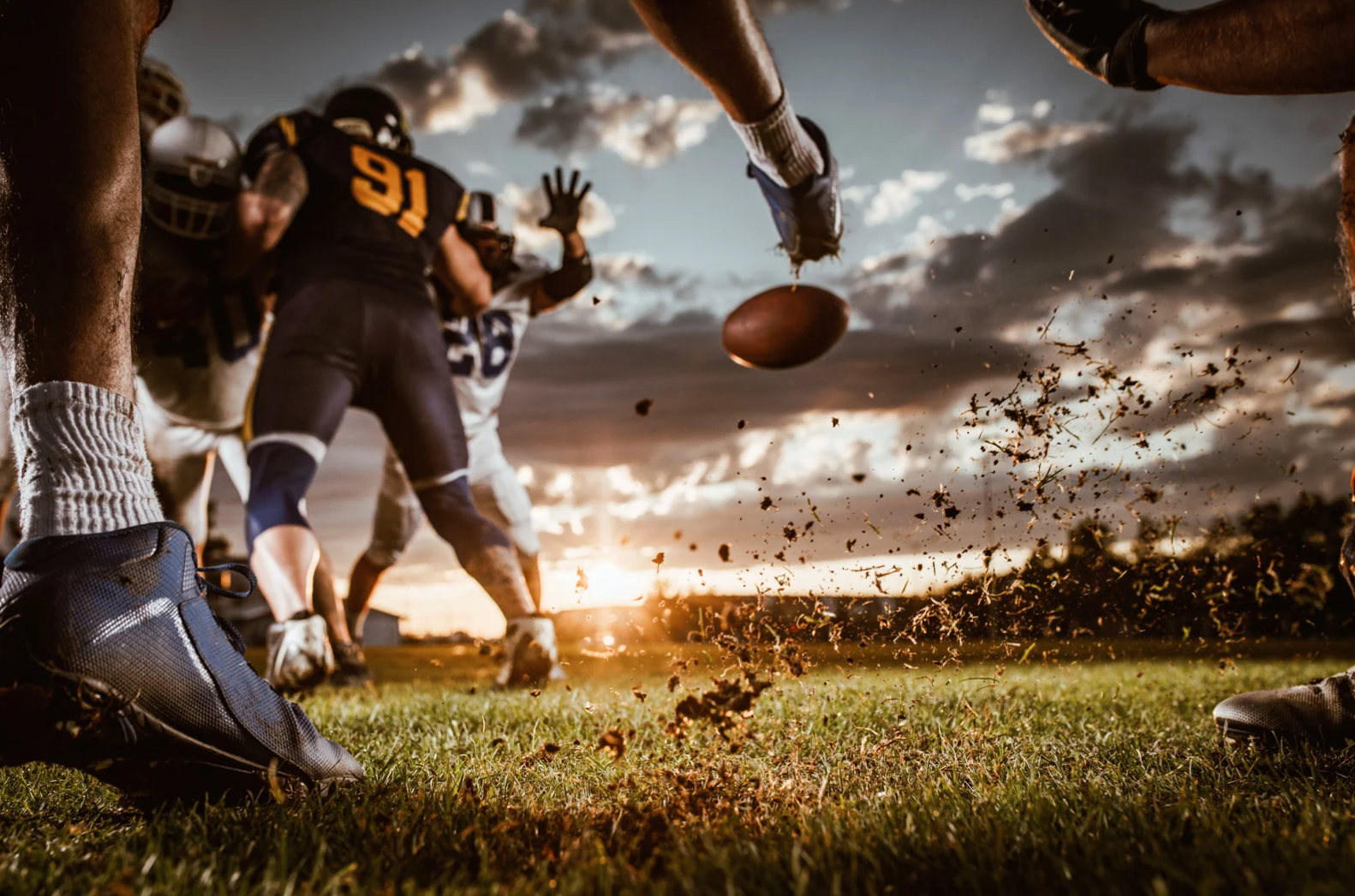
As the crisp autumn air settles in and stadium lights brighten Friday nights and Saturday afternoons, football season is in full swing. The sport, known for its high-energy plays and intense competition, brings communities together. It also brings a unique set of physical challenges for the athletes who leave it all on the field. Understanding the most common injuries in football, particularly those affecting the shoulders and knees, is crucial for players, parents, and coaches.
At Sagewell Orthopaedics, we focus on helping athletes of all levels navigate their wellness journeys. Our own Dr. Scott Strasburger, a Nebraska Football Hall of Famer and expert in complex shoulder issues and shoulder-to-toe orthopaedics, recently joined the Carriker Chronicles to discuss the physical demands of modern football. He shared insights on everything from player conditioning to the intricacies of injury recovery. This discussion highlights the importance of knowledgeable care when dealing with sports-related orthopaedic concerns.
This blog will explore some of the common shoulder and knee injuries seen in football and discuss the approaches that may help athletes manage their recovery and return to the game they love.
The Shoulder: A Complex Joint Under Pressure
The shoulder is one of the most mobile joints in the body, but this wide range of motion also makes it susceptible to injury, especially in a contact sport like football. Tackles, falls, and repetitive throwing motions can all place significant stress on the shoulder complex.
Common Shoulder Injuries in Football
Rotator Cuff Issues: The rotator cuff is a group of four muscles and their tendons that surround the shoulder joint, keeping the head of your upper arm bone firmly within the shoulder socket. Overuse from throwing or sudden trauma from a tackle can lead to inflammation or tears in these tendons, causing significant discomfort and weakness.
Shoulder Instability and Dislocations: A powerful hit can sometimes force the ball of the shoulder joint out of its socket, an injury known as a dislocation. Even if the shoulder doesn't fully dislocate, it can become unstable, leading to a feeling of looseness or repeated partial dislocations (subluxations). This can affect a player's confidence and ability to perform at their peak.
AC Joint Sprains: The acromioclavicular (AC) joint is where the collarbone meets the shoulder blade. A direct fall onto the shoulder is a common cause of an AC joint sprain, often called a "shoulder separation." This can result in noticeable discomfort and a visible bump on top of the shoulder, with the severity depending on which ligaments are affected.
Approaches to Shoulder Wellness
Managing shoulder injuries often starts with a comprehensive evaluation to understand the specific structures involved. As Dr. Strasburger is an expert in complex shoulder conditions, he understands that a personalized approach is key. Management strategies often involve a period of rest and activity modification to allow the initial irritation to subside.
A structured physical therapy program is frequently a cornerstone of recovery. These programs are designed to progressively restore range of motion, build strength in the surrounding muscles, and improve joint stability. For athletes, therapy often includes sport-specific exercises that simulate the movements required on the field, helping to prepare the shoulder for a safe return to play. In some cases, more advanced interventions may be considered to address the underlying issue and support long-term joint health.
The Knee: Bearing the Brunt of the Game
From planting a foot to make a sharp cut to absorbing the force of a tackle, a football player's knees are constantly under duress. The combination of high-speed running, sudden stops, and direct contact makes the knee one of the most frequently injured areas in the sport.
Common Knee Injuries in Football
Ligament Sprains and Tears (ACL, MCL, PCL): The knee is stabilized by a network of strong ligaments. The anterior cruciate ligament (ACL) is often injured during non-contact movements like pivoting or landing from a jump, while the medial collateral ligament (MCL) is more commonly affected by a hit to the outside of the knee. Posterior cruciate ligament (PCL) injuries can occur from a direct blow to the front of the knee. These injuries can cause a feeling of instability and make it difficult to bear weight.
Meniscus Tears: The meniscus is a C-shaped piece of tough cartilage that acts as a shock absorber between the shinbone and thighbone. Twisting or squatting motions, especially under the force of a tackle, can cause this cartilage to tear. This may lead to sensations of catching, locking, or swelling in the knee.
Patellofemoral Discomfort: This refers to discomfort felt at the front of the knee and around the kneecap (patella). In athletes, it can be caused by overuse or improper tracking of the kneecap in its groove. While not always tied to a single traumatic event, it can significantly limit a player's ability to run, jump, and perform.
Supporting Knee Health and Recovery
As discussed by Dr. Strasburger on the Carriker Chronicles, recovering from a significant knee injury is a marathon, not a sprint. The mental aspect of recovery — regaining confidence in the knee's stability — is just as important as the physical healing. Modern orthopaedic care emphasizes a patient-centered approach that addresses both.
Initial management often includes conservative strategies to reduce swelling and discomfort. Following a thorough diagnosis, a guided rehabilitation plan may be recommended. Physical therapy for knee injuries focuses on restoring range of motion, strengthening the quadriceps, hamstrings, and hip muscles to provide better support for the joint, and improving balance and coordination. The goal is to create a stable and functional joint that can withstand the demands of football.
For more complex injuries, surgical intervention may be an option to reconstruct damaged ligaments or repair torn cartilage. As Dr. Strasburger noted, surgical techniques and rehabilitation protocols have advanced significantly, allowing many athletes to make a full return to their sport.
Charting Your Course Back to the Field
Understanding the nature of common football injuries is the first step toward prevention and effective management. Conditioning, proper technique, and listening to your body are all essential components of staying healthy throughout the season.
To hear more expert insights on athlete health, recovery, and the physical evolution of the game, we encourage you to watch Dr. Scott Strasburger's recent appearance on the Carriker Chronicles.
If you are experiencing ongoing discomfort or have concerns about a sports-related injury, seeking a professional evaluation is a proactive step toward getting back to your life and the activities you enjoy. At Sagewell Orthopaedics, we believe in a philosophy 'Where wisdom meets wellness.', combining deep expertise with compassionate, individualized care. Contact us to schedule a consultation and let us help you navigate your journey to recovery.
